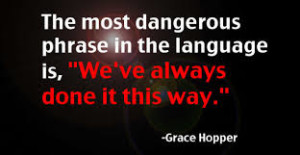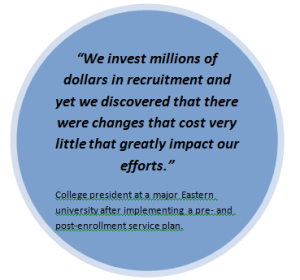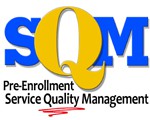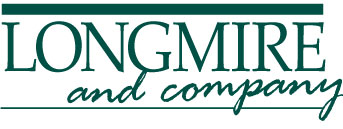I have been fielding a number of calls this past week from enrollment managers and admission directors who have questions about our blog series on pre-enrollment service delivery. One highly-respected enrollment manager said that five different staffers forwarded a copy of the post to him. “My first reaction was that everyone was searching for a reason outside of their own sphere that would explain some of our enrollment challenges,” he said. “Then, I got honest with myself. We have a great college here, but can we do better? How do we stack up with our competition? Are gaps in service impacting our ability to make our enrollment goals?“
 All good questions and we have answers.
All good questions and we have answers.
- Yes, you CAN, and should, provide better pre-and post-enrollment service. The research is very clear: As an industry, higher education ranks behind banks and cell phone service providers for providing exemplary service. Seriously, when was the last time you heard anyone say anything positive about either of those?
- Understanding how you compare to the schools that you compete with isn’t just nice to know, it is NEED to know. Our Service Quality Management (SQM) tool offers the ability to compare your service delivery to your direct competitors as well as to institutions across the United States because we have seen the impact that data can make on a college’s enrollment.
- And, yes, your pre-enrollment service delivery DOES impact your enrollment. Over half of students and their parents told us that the pre-enrollment service they receive from a college influences their selection decision and 25% of those told us they had eliminated a formerly highly attractive college from consideration on the basis of receiving poor service traced to one or more brand touch points. They also say that service is one of the best ways to differentiate one college from another. The fact is: Prospective students and parents view the pre-enrollment service they receive as predictive of how the student will be served after enrollment. They will avoid colleges that exhibit bad service during the “college shopping” process.
If you are like many admission departments leading the charge to improve the service you provide the students you are recruiting, here are some common pitfalls you want to avoid.
Pitfall # 1: Making assumptions.
If you are relying on gut feel or anecdotal evidence to evaluate your college’s level of service delivery, you are making assumptions that can, and will, derail your enrollment efforts. You are probably familiar with this modern proverb: “When you assume, you make an ASS out of U and ME.”
Do This Instead: Measure it so you can manage it.
If you don’t measure it, you can’t manage it. First, benchmark your current state. Knowing your service strengths and weaknesses is a critical component. A baseline study will allow you to prioritize which areas need the most work, what should take precedence and which of your strongest attributes you should focus on in your recruiting efforts.
An added bonus, a credible baseline measurement report is a powerful tool to have when you are seeking buy-in from other departments or even your administration.
Need more information about establashing a Baseline Measurement? (Review here.)
Pitfall #2: Falling into the “That’s the way we’ve always done it” trap.
Perhaps you currently gather feedback from prospective and current students in an effort to monitor your student service delivery. But, are you asking the right questions?
For example, most colleges survey students and parents after a visit. Were we friendly? Did we provide the information you needed? Was the tour guide engaging? Did you like our campus and community? What did you like most and least about your visit? What improvements can we make?
These may seem like good questions but they don’t tell you much.
Do This Instead: Ask questions that tell you if your campus visit “moved the student’s needle” in your favor.
The right questions can give you tremendous insight. For example: Did your campus tour guide make you more or less excited about attending? If so, by how much? Why? Did you find the city/community more or less exciting and inviting than other colleges you visited? If so, what made it more or less exciting? To what degree do you feel we took a personal interest in you? Did that make a difference in your desire to enroll here? Did your view of our college change as a result of your visit? If so, how? For better or worse? How can we better show you what your life will be like as a student here?
This just scratches the surface of the range and depth of questions you can ask. Don’t be afraid to ask penetrating questions of students and parents after a visit. Let students and parents know that your purpose is to better serve them, and future students, by gaining a greater understanding.
Pitfall #3: Going it alone.
In our experience, the admissions department naturally takes the lead in the development of a pre-and post-enrollment service plan. But not involving the entire campus is a big mistake.
Do This Instead: Reach out campus-wide.
Colleges and universities that score the highest in pre-enrollment service are those that view prospective students and their parents as important customers. They typically engage every person on campus in a customer service plan with clear and actionable instructions and objectives. Most importantly, they express to each person how key their role is, and offer specific ways they can help the institution improve provide the best possible customer service.
In order for real transformation to occur, every member of every department must be apprised of the plan and committed to creating a more positive experience. Certainly, interactions with faculty, admissions and financial aid are critical, but many schools are surprised to find the impact that campus maintenance, grounds keeping, security and even the switchboard operators can have on establishing an impression. Imagine the institution as a very large rowboat, where each individual rower is moving in harmony with hundreds of other rowers, propelling the craft swiftly and seamlessly through the water. With everyone working toward the same goals, progress will be inevitable, and apparent to your prospects.
The research suggests that for most colleges, improved pre-enrollment service offers an immediate opportunity to differentiate themselves in a highly-competitive marketplace. Best time to start the process? Today!
Longmire and Company offers Service Quality Management (SQM) surveys to help you achieve these goals. And we conduct workshops on campus to help colleges chart their course in providing better service to prospective and current students. Contact me today and I will show you how we can help you measure and manage your pre-enrollment service. Continue the conversation on Twitter @LongmireCo.
 Rick Montgomery is as an Enrollment Strategist at Longmire and Company. With over 20 years in higher education marketing, he brings an innovative and dynamic approach to helping colleges and universities meet their enrollment goals. Rick can be reached at 913/492.1265 x.708 or via email at rmontgomery@longmire-co.com.
Rick Montgomery is as an Enrollment Strategist at Longmire and Company. With over 20 years in higher education marketing, he brings an innovative and dynamic approach to helping colleges and universities meet their enrollment goals. Rick can be reached at 913/492.1265 x.708 or via email at rmontgomery@longmire-co.com.







